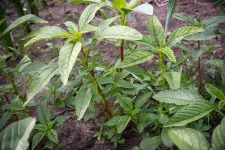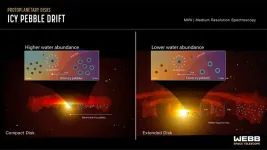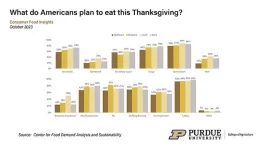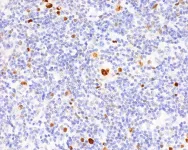(Press-News.org) URBANA, Ill. — Waterhemp, the aggressive weed threatening Corn Belt crop production, is throwing curveballs once again, according to researchers at the University of Illinois Urbana-Champaign. The weed has famously developed resistance to not one or two, but seven herbicide sites-of-action classes, nearly exhausting the chemical tools farmers can use to defend their livelihood.
In a new Weed Science study, U. of I. researchers show that a single major gene is responsible for waterhemp’s resistance to S-metolachlor (active ingredient in Dual Magnum and Dual II Magnum), an important soil-applied residual product in the class of VLCFA-inhibiting herbicides. The group’s previous research showed waterhemp detoxifies the chemical with P450s, enzymes that remove electrons from toxic compounds, making them less reactive inside plant cells.
“The lingering question was which P450s? Plants have hundreds of them, and they often work in tandem to deactivate toxins. So, when we found just one major gene responsible for S-metolachlor resistance in waterhemp, we were very surprised,” said study co-author Dean Riechers, professor in the Department of Crop Sciences, part of the College of Agricultural, Consumer and Environmental Sciences (ACES) at U. of I. “Waterhemp threw us a curveball once again.”
Riechers’ group routinely hunts for genes responsible for waterhemp’s herbicide-dodging superpowers. A decade ago, his group traced waterhemp’s resistance to atrazine — a herbicide in a separate class from S-metolachlor — to a single GST gene. But he says it’s rare to find simple genetic control for a non-target-site resistance mechanism in weeds.
Tracing the genetic basis of resistance takes a great deal of hard work, precision, and time. In this case, first author Dylan Kerr, Riechers’ master’s student at the time, selected resistant plants and iteratively crossed them with other resistant plants for three generations in the greenhouse. Having purified the genetic stock, he then mated resistant parents with sensitive ones and looked for genetic differences in their offspring.
“Studying soil-applied herbicide resistance is very difficult because if the herbicide is doing its job, then sensitive plants won't even exist,” Riechers said. “Dylan went above and beyond the call of duty. He was very diligent and persistent in the greenhouse in making these crosses so the results would be clean and easy to interpret.”
What does it mean that only one major gene controls S-metolachlor resistance in waterhemp?
“Unfortunately, it’s not encouraging news for growers,” Riechers said. “Whenever resistance is controlled by a single gene and it’s a dominant trait, the risk for spread is higher.”
The worst-case scenario hasn’t happened yet. Riechers notes that metolachlor has been used in corn, soybean, and grain sorghum for about 45 years, and waterhemp populations with resistance to the herbicide are not yet widespread.
“As a soil-applied residual tool, S-metolachlor is valuable for managing waterhemp,” Riechers said. “Resistance is not a huge problem yet, but if S-metolachlor or other VLCFA-inhibitor herbicides ever stopped working on a broader scale, that would take even more effective tools away.”
The way forward, Riechers says, is for the industry to move toward more holistic weed management methods — including physically destroying seeds and adding more diverse crops to the rotation — and away from complete reliance on chemical weed control. He suggests that planting winter wheat, cover crops, or even double-cropping soybeans after wheat could significantly cut down on weed pressure.
“I realize it’s getting tiring to keep saying diversify your weed control, but it’s true and our research findings at ACES support this strategy,” Riechers said.
The study, “Inheritance of resistance to S-metolachlor in a waterhemp (Amaranthus tuberculatus) population from central Illinois,” is published in Weed Science [DOI: 10.1017/wsc.2023.63]. Authors include Dylan R. Kerr, Jeanaflor Crystal T. Concepcion, and Dean E. Riechers. The research was supported in part by Syngenta Ltd., UK.
END
Single gene controls Corn Belt weed's resistance to soil-applied herbicide
2023-11-08
ELSE PRESS RELEASES FROM THIS DATE:
Your education and income level may affect your survival, recovery from stroke
2023-11-08
EMBARGOED FOR RELEASE UNTIL 4 P.M. ET, WEDNESDAY, NOVEMBER 8, 2023
MINNEAPOLIS – People with low education and income levels may have a 10% increased risk of death or being dependent on others to complete daily tasks three months after a stroke compared to people with high education and income levels, according to new research published in the November 8, 2023, online issue of Neurology®, the medical journal of the American Academy of Neurology. The study does not prove that low education and income cause worse outcomes after stroke. It only shows an association.
“Compared ...
For epilepsy, yoga may be good for your mind
2023-11-08
EMBARGOED FOR RELEASE UNTIL 4 P.M. ET, WEDNESDAY, NOVEMBER 8, 2023
MINNEAPOLIS – For people with epilepsy, doing yoga may help reduce feelings of stigma about the disease along with reducing seizure frequency and anxiety, according to new research published in the November 8, 2023, online issue of Neurology®, the medical journal of the American Academy of Neurology.
“People with epilepsy often face stigma that can cause them to feel different than others due to their own health condition and that can have a significant impact on their quality of life,” said study author ...
Increasing workplace flexibility associated with lower risk of cardiovascular disease
2023-11-08
Embargoed for release: Wednesday, November 8, 4:00 PM ET
Key points:
In a randomized trial of the cardiometabolic impacts of workplace interventions designed to reduce work-family conflict, older employees and those at baseline higher risk for cardiometabolic disease saw their risk of developing cardiovascular disease decrease equivalent to five to 10 years of age-related cardiometabolic changes.
The study is among the first to assess whether changes to the work environment can affect cardiometabolic risk.
Boston, MA—Increasing workplace flexibility may lower employees’ risk of cardiovascular disease, according to a new ...
New interactive evidence-based mapping tool gives policymakers more insight into highly concentrated cannabis products
2023-11-08
After conducting the first scoping review of its kind, researchers at the University of Colorado Anschutz Medical Campus have developed an evidence based interactive mapping tool to assist policymakers as they consider regulating the concentration of THC in cannabis products and as more potent products move into the marketplace.
Their review, funded by the State of Colorado, was released today in the American Journal of Public Health (AJPH).
“We looked at studies that measured adverse or beneficial effects of high concentration ...
Independent monitoring of the WHO pandemic agreement is non-negotiable, experts say
2023-11-08
An accountability framework, including independent monitoring of state compliance, is critical for the pandemic agreement's success, according to researchers at Columbia University Mailman School of Public Health and affiliates at Spark Street Advisors. The paper and findings are published in BMJ Global Health.
“Countries signing up to a pandemic agreement is no guarantee of its effective implementation,” said Nina Schwalbe, adjunct assistant professor in the Department of Population and Family Health and principal visiting fellow at Columbia Mailman School. “Countries' lack of compliance with ...
NASA’s Webb findings support long-proposed process of planet formation
2023-11-08
Scientists using NASA’s James Webb Space Telescope just made a breakthrough discovery in revealing how planets are made. By observing water vapor in protoplanetary disks, Webb confirmed a physical process involving the drifting of ice-coated solids from the outer regions of the disk into the rocky-planet zone.
Theories have long proposed that icy pebbles forming in the cold, outer regions of protoplanetary disks — the same area where comets originate in our solar system — should be the fundamental seeds of planet formation. The main requirement of these theories is that pebbles should drift inward toward the star due to friction in the gaseous disk, ...
UTIA faculty member serves as editor of the Journal of Food Distribution Research
2023-11-08
Carlos Trejo-Pech, an associate professor in the Department of Agricultural and Resource Economics at the University of Tennessee Institute of Agriculture, is a newly appointed editor of the Journal of Food Distribution Research.
“It is a great honor and big responsibility to serve as a journal editor of a publication outlet in the agricultural economics and agribusiness discipline,” said Trejo-Pech. “We, the editors, are committed to disseminating the results of high-quality research.”
The journal was established in 1969 under the auspices of the Food Distribution Research Society, the only body of scholars and practitioners in the United States dedicated ...
October Consumer Food Insights Report highlights thanksgiving meal plans
2023-11-08
October Consumer Food Insights Report highlights Thanksgiving meal plans
WEST LAFAYETTE, Ind. – Nearly eight in 10 Americans will celebrate the upcoming Thanksgiving holiday with a special meal, according to the October 2023 Consumer Food Insights Report.
The survey-based report out of Purdue University’s Center for Food Demand Analysis and Sustainabilityassesses food spending, consumer satisfaction and values, support of agricultural and food policies, and trust in information sources. Purdue ...
Hodgkin’s lymphoma: Small change, big effect
2023-11-08
Hodgkin’s lymphoma is one of the most common types of lymphoma in young adults. It is characterized by the presence of enlarged B lymphocytes, which are unusual in that they bear on their surface the identifying markers of many other immune cells – such as those found on phagocytes, dendritic cells, or T cells. Now, a team led by Stephan Mathas from the Experimental and Clinical Research Center (ECRC) has explained how these changes take place in the cells and what impact they have. The ECRC is a joint institution of the Max Delbrück Center and Charité – Universitätsmedizin Berlin.
“Many different ...
How animals get their stripes and spots
2023-11-08
Nature has no shortage of patterns, from spots on leopards to stripes on zebras and hexagons on boxfish. But a full explanation for how these patterns form has remained elusive.
Now engineers at the University of Colorado Boulder have shown that the same physical process that helps remove dirt from laundry could play a role in how tropical fish get their colorful stripes and spots. Their findings were published Nov. 8 in the journal Science Advances.
“Many biological questions are fundamentally ...







